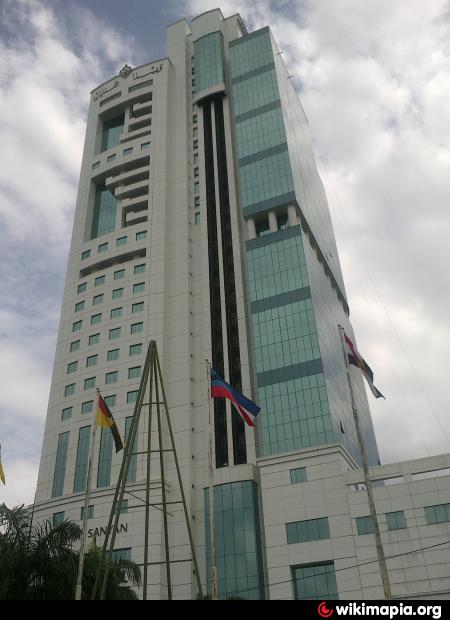MOUNT SANTUBUNG
 Set under the spectacularly steep 810m peak of Gunung Santubong, the
Santubong Peninsula is home to Sarawak's finest beach resorts and its famous Cultural
Village and only 35 minutes drive from Kuching.
According to the Encyclopaedia of Iban Studies the original inhabitants
of Santubong were the Iban.
Si-antu-ubong means 'spirit boat' in the Iban language. Antu is hantu in
Malay which means spirit or ghost. Santubong are boat like coffins made from a
single hollow log designed to represent the vesell in which a dead person will
travel from this world to afterlife. Following another theory, the name
Santubong is derived from "san choo bong" in the Hakka Chinese dialect, meaning "wild pig king" or "king of wild
pig".
Set under the spectacularly steep 810m peak of Gunung Santubong, the
Santubong Peninsula is home to Sarawak's finest beach resorts and its famous Cultural
Village and only 35 minutes drive from Kuching.
According to the Encyclopaedia of Iban Studies the original inhabitants
of Santubong were the Iban.
Si-antu-ubong means 'spirit boat' in the Iban language. Antu is hantu in
Malay which means spirit or ghost. Santubong are boat like coffins made from a
single hollow log designed to represent the vesell in which a dead person will
travel from this world to afterlife. Following another theory, the name
Santubong is derived from "san choo bong" in the Hakka Chinese dialect, meaning "wild pig king" or "king of wild
pig".
TUMBINA BINTULU
Taman Tumbina Bintulu is an integration of a botanical and zoological garden.
The name TUMBINA originates from the Malay words TUMbuhan (meaning Plant) and
BINAtang (animal). Tumbina was created with a vision to be A Living Heritage Of The Flora &
Fauna Of Borneo. The objectives are (i) Recreation, (ii) A Unique Tourism
Product, (iii) Education, (iv) Conservation and (v) Research &
Development.
FLORA AND FAUNA
Flora of TumbinaThe plant collection at Tumbina
encompasses a wide variety of native and introduced species. Natural vegetations
are found everywhere around Tumbina. Areas for different types of plants are
created by enhancing and utilizing the natural environment of Tumbina.
 Fauna of TumbinaClasses of animals found at
Tumbina are Mammal, Aves, Pisces, Reptiles and Insecta.
Fauna of TumbinaClasses of animals found at
Tumbina are Mammal, Aves, Pisces, Reptiles and Insecta.
The majority are
native fauna of Borneo. Introduced animals such as Flamingo, Ostrich and Tiger
are mainly for attraction and educational purposes only.

MIRI CROCODILE FARM
 The Miri Crocodile Farm at Kuala Baram, 24km from Miri, is home to more than 1,000 estuarine crocodiles and false gharials. It also features a snake house and a small zoo. The farm is fully CITES registered.
The Miri Crocodile Farm at Kuala Baram, 24km from Miri, is home to more than 1,000 estuarine crocodiles and false gharials. It also features a snake house and a small zoo. The farm is fully CITES registered.
BAKO NATIONAL PARK
 Bako is one of the smallest national parks in Sarawak. However, it features
multiple biomes (including rainforest), abundant wildlife, jungle streams and
waterfalls, secluded beaches, and trekking trails. A network of 16 marked
walking trails of different lengths allows visitors access. In addition, various
beaches are accessible by boat from Kampung Bako or Teluk Assam, as well as a
geologically interesting sea stack rock formation. The range of attractions and
activities in a compact area have made Bako one of the most popular parks in
Sarawak.
FLORA AND FAUNA
Bako contains almost every type of plant life found in Borneo, with over 25
distinct types of vegetation from seven complete ecosystems: beach vegetation, cliff vegetation,
kerangas or heath forest, mangrove forest, mixed
dipterocarp
forest, padang or grasslands vegetation and peat swamp
forest. The unusual plant
life includes a variety of carnivorous plants (four species of pitcher plants, sundews, bladderworts) as well as a huge
variety of tree and other plant species.
Bako is also home to a number of lizards and snakes, most of which are
harmless. Bako is a fascinating place for bird watching, with over 150 species
recorded. Bako's nocturnal creatures include the colugo, pangolin, mousedeer, various species of fruit-eating and
insect-eating bats, tarsier, slow loris and palm
civet.
Bako is one of the smallest national parks in Sarawak. However, it features
multiple biomes (including rainforest), abundant wildlife, jungle streams and
waterfalls, secluded beaches, and trekking trails. A network of 16 marked
walking trails of different lengths allows visitors access. In addition, various
beaches are accessible by boat from Kampung Bako or Teluk Assam, as well as a
geologically interesting sea stack rock formation. The range of attractions and
activities in a compact area have made Bako one of the most popular parks in
Sarawak.
FLORA AND FAUNA
Bako contains almost every type of plant life found in Borneo, with over 25
distinct types of vegetation from seven complete ecosystems: beach vegetation, cliff vegetation,
kerangas or heath forest, mangrove forest, mixed
dipterocarp
forest, padang or grasslands vegetation and peat swamp
forest. The unusual plant
life includes a variety of carnivorous plants (four species of pitcher plants, sundews, bladderworts) as well as a huge
variety of tree and other plant species.
Bako is also home to a number of lizards and snakes, most of which are
harmless. Bako is a fascinating place for bird watching, with over 150 species
recorded. Bako's nocturnal creatures include the colugo, pangolin, mousedeer, various species of fruit-eating and
insect-eating bats, tarsier, slow loris and palm
civet.















